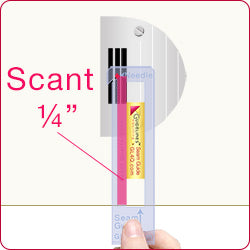Full 1/4" or Scant 1/4"?
The Answer is Both Because the thread and fold in a seam have some width.
To compensate for that, you sew slightly less than a full ¼” so your finished seams actually come out measuring a full ¼”.
Installment payment options available at checkout
Full 1/4" or Scant 1/4"?
The Answer is Both Because the thread and fold in a seam have some width.
To compensate for that, you sew slightly less than a full ¼” so your finished seams actually come out measuring a full ¼”.
Everything works
perfectly on paper.
But when you actually start working with fabric & thread, it gets more complicated.
The solution is to sew a scant ¼” (1 to 2 threads smaller than ¼”), so what “Looks Good on Paper” will come out Perfectly with Fabric.
Full 1/4" or Scant 1/4"?
The Answer is Both Because the thread and fold in a seam have some width.
To compensate for that, you sew slightly less than a full ¼” so your finished seams actually come out measuring a full ¼”.
Everything works
perfectly on paper.
But when you actually start working with fabric & thread, it gets more complicated.
The solution is to sew a scant ¼” (1 to 2 threads smaller than ¼”), so what “Looks Good on Paper” will come out Perfectly with Fabric.
The super easy way to align a Seam Guide at a scant ¼" on your sewing machine.

Sarah Sheckells Lenoir, NC
"Just wanted to tell you I love this thing - Super Easy Seam Guide Setter! I put it on right away and have had great success with keeping my 1/4” seams accurate.”
The super easy way to align a Seam Guide
at a scant ¼" on your sewing machine.
Super Easy
Seam Guide Setter

Sarah Sheckells Lenoir, NC
"Just wanted to tell you I love this thing - Super Easy Seam Guide Setter! I put it on right away and have had great success with keeping my 1/4” seams accurate.”
A Scant 1/4" also helps you get
pointy points in blocks like these:
A Scant 1/4" is slightly less than a full 1/4" and it also helps you get pointy points in blocks like these:
Using the top row of this Ohio Star as an example, before sewing the rows together, the points should be a full ¼” from the raw edges.
The goal is to stick the Seam Guide in front of the presser foot of your sewing machine to help guide your fabric before it goes under the needle.
The Super Easy Seam Guide Setter makes it easy to align the Seam Guide so it's a Scant ¼” to the right of the needle.
Guiding your fabric against the edge of the Seam Guide makes it much easier to sew consistently, accurate Scant ¼” seam allowances.
Seam Guides are repositionable, removable and leave no sticky residue.
The Super Easy Seam Guide Setter makes it easy to set a scant ¼” guide on your sewing machine.
The goal is to stick the Seam Guide in front of the presser foot of your sewing machine to help guide your fabric before it goes under the needle.
The Super Easy Seam Guide Setter makes it easy to align the Seam Guide so it's a Scant ¼” to the right of the needle.
Guiding your fabric against the edge of the Seam Guide makes it much easier to sew consistently, accurate Scant ¼” seam allowances.
Seam Guides are repositionable, removable and leave no sticky residue.
More Sewing Aids Tools
The Prep-Tool is a Scant 1/4" wide:
Its lip edges make it easy to butt it up against the fabric's edge
and mark an accurate scant 1/4" seam line.
Prep-Tool
with 8-Page Booklet & a Seam Guide
Patterns often tell you to stop a ¼” from the edge of the fabric. What they really mean is stop right at the seam line, which is a scant ¼”. That’s the secret to sharp mitered binding corners and precise set in seams.
The Prep-Tool is a Scant 1/4" wide:
Its lip edges make it easy to butt it up against the fabric's edge and mark an accurate scant 1/4" seam line.
Accurately pre-trim triangle points: